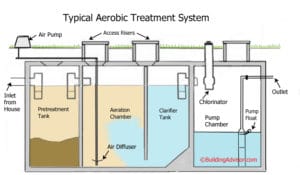Q: Do you consider an aerobic-treatment system a good option for a waterfront vacation home? We are looking at upgrading a 40-year-old septic system.
I will do more research, but for now with the aerobic systems that need pumps and fans, I have two questions:
1) What happens during a power outage? We had a five-day outage over Christmas.
2) Are these systems appropriate for a property that is used seasonally? The house has heavy use of 10-plus people four months of the year, very light use by 1-6 people on weekends only for four months, and moderate use in between.
We are waterfront and new code requires the leach field to be 100 feet back. It is currently much closer, as it was built under old codes. — Michelle
A: A properly functioning aerobic treatment unit (ATU) will produce cleaner effluent than a traditional septic system, so these are becoming more common on waterfront properties where discharge from septic systems often faces tougher restrictions. Depending on the system design, the ATU might discharge to a reduced-size leach field, to a subsurface drip system, or an above-ground spray irrigation system (requiring a large area).
While these systems are highly effective, they can cost two to three times as much as a conventional system and require more frequent pumping, inspection, and maintenance. A maintenance contract with a competent service provider is highly recommended. Septic systems are very corrosive to the electrical and mechanical components found in these and other alternative systems.
There are many types of ATUs on the market, but all have in common a blower that forces air into an aeration chamber to support aerobic bacteria that break down the effluent. Conventional septic systems rely primarily on anaerobic bacteria, which is a less efficient process.
Pre-packaged systems have up to four chambers for collecting, aerating, clarifying, and pumping the effluent. The first chamber is a smaller version of a conventional septic tank where solids are allowed to settle out, and the second “treatment” chamber is used to pump air into the effluent. Some systems add a clarification tank and pumping chamber. Chlorination may be added for systems that discharge to the surface.

In addition to the blower, most systems have an effluent pump to discharge the effluent to the leach field or other discharge system. Some sophisticated multi-chamber systems also use an additional pump to recirculate the sludge from the clarification chamber back to the aeration chamber. If the tank is uphill from the home’s main sewer line, you will need a pumping station and yet another pump. Power is also needed for the alarm system, which alerts you to system malfunctions.
A power failure of 24 hours or less usually isn’t a problem for aerobic systems, but longer outages can harm the bacteria that break down the effluent. In that case, you would need to gradually restart the system, perhaps with a visit from your service provider.
A longer outage, however, is going to cause serious problems with any type of pumped septic system. Both conventional and alternative systems are generally designed to store a one-day load of effluent. With a power outage, sewage will start to back up into the home, first on the lower levels of the home.
Experts recommend reducing your water usage as much as possible during an outage. If your well pump is not working either, you may not have much water to dispose of anyway. When the power comes back on, you should ask your service provider about restarting your system. A pump on a timer will generally restore itself over time, while an “on demand” pump may require you to run it for short intervals of 2-5 minutes every 4-6 hours until the pump turns off on its own during the run time.
There may be a period of time where the discharged effluent is less purfied than it should be.
Regarding seasonal use, that should not be a problem as long as the system is designed for the anticipated load. If the house has not been used for several months, it’s best to hold off on heavy water uses, such as laundry, for several days to let the system get up and running. It takes time for the bacteria to be restored to healthy levels. As with any septic system, you should follow the usual care and maintenance tips required for good performance.
These include spacing out laundry loads, baths and showers, and other heavy water uses and being careful about what goes down the drain. This includes all harsh chemicals, grease and fat, antibacterial products, and paper products such as facial tissue or paper towels. Garbage disposals should not be used.
Following these guidelines is especially important with aerobic systems, as they are more sensitive to chemicals, grease, and other contaminants. They are also less able to handle large surges of water, a potential problem when your house is filled with guests.
A three-bedroom house is designed for 6 people, so if you have 10 people taking showers in a row, that would put a strain on the system. I would suggest discussing this with the system designer, who may recommend a larger-capacity system than required by code. Also, if long power outages are common in your area, you might consider a backup generator for both your well pump and septic system. — Steve Bliss, Editor, BuildingAdvisor.com
Read More on Alternative Septic Systems Septic System Maintenance
Leave a Reply